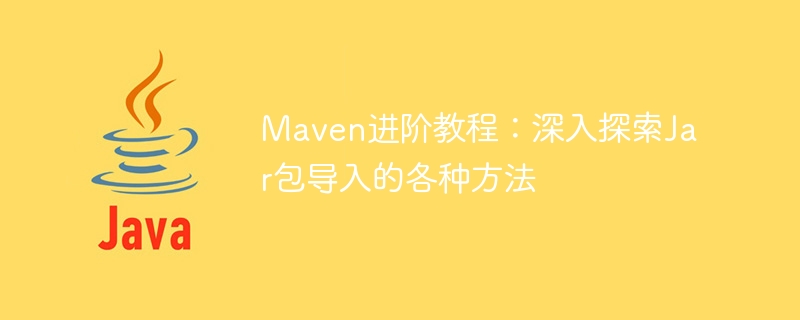

Title: Maven Advanced Tutorial: In-depth exploration of various methods of Jar package import
As a Java project management tool, Maven is widely used in project construction and dependency management etc. In the actual development process, we often use Jar packages of various third-party libraries, and how to effectively import Jar packages has become a skill that must be mastered. This article will delve into the methods of importing Jar packages in Maven, including using local Jar packages, remote warehouse Jar packages, and custom Jar packages. It will also give specific code examples to help readers better understand and apply these techniques. .
In the pom.xml file of the Maven project, you can import by specifying the system path of the local Jar package , the sample code is as follows:
<dependency>
<groupId>com.example</groupId>
<artifactId>example</artifactId>
<version>1.0</version>
<scope>system</scope>
<systemPath>${basedir}/lib/example.jar</systemPath>
</dependency>First install the local Jar package to the local Maven repository, execute the following command in the command line:
mvn install:install-file -Dfile=path/to/example.jar -DgroupId=com.example -DartifactId=example -Dversion=1.0 -Dpackaging=jar
Then Introduce this dependency in the pom.xml file:
<dependency>
<groupId>com.example</groupId>
<artifactId>example</artifactId>
<version>1.0</version>
</dependency>Maven will download the Jar package from the central warehouse by default , you only need to add the corresponding coordinates in the pom. Package, you can add warehouse configuration in pom.xml, the sample code is as follows:
<dependency>
<groupId>junit</groupId>
<artifactId>junit</artifactId>
<version>4.12</version>
<scope>test</scope>
</dependency><repositories>
<repository>
<id>custom-repo</id>
<url>http://example.com/maven-repo/</url>
</repository>
</repositories>3. Custom Jar package import
For Some customized Jar packages can be packaged and uploaded to the Maven repository through the Maven plug-in, and then the dependencies can be introduced for use. The sample code is as follows:
<dependency>
<groupId>com.example</groupId>
<artifactId>example</artifactId>
<version>1.0</version>
</dependency><plugin>
<groupId>org.apache.maven.plugins</groupId>
<artifactId>maven-deploy-plugin</artifactId>
<version>2.7</version>
<configuration>
<url>http://example.com/maven-repo</url>
</configuration>
</plugin>Finally introduce dependencies in pom.xml:
mvn deploy:deploy-file -Dfile=path/to/example.jar -DgroupId=com.example -DartifactId=example -Dversion=1.0 -Dpackaging=jar -Durl=http://example.com/maven-repo
Through the introduction of this article, readers can have a more comprehensive understanding There are various ways to import Jar packages in Maven, including local Jar packages, remote warehouse Jar packages, and custom Jar packages. I hope these specific code examples can help readers use Maven to manage dependencies more flexibly in actual projects and improve development efficiency.
The above is the detailed content of Maven Advanced Tutorial: In-depth exploration of various methods of Jar package import. For more information, please follow other related articles on the PHP Chinese website!




